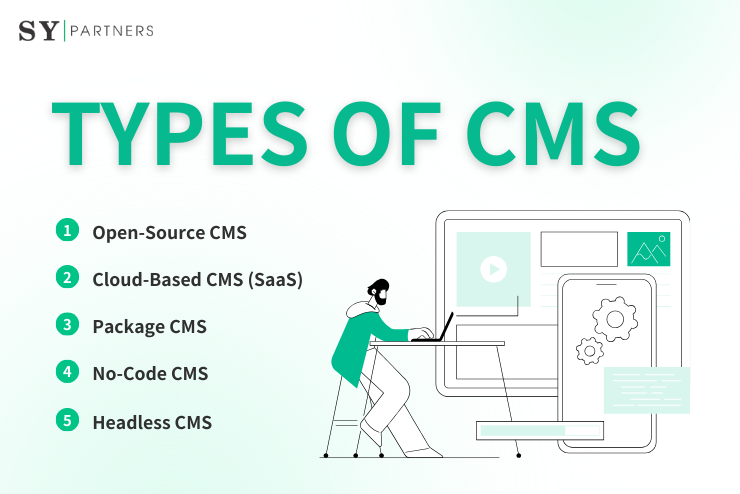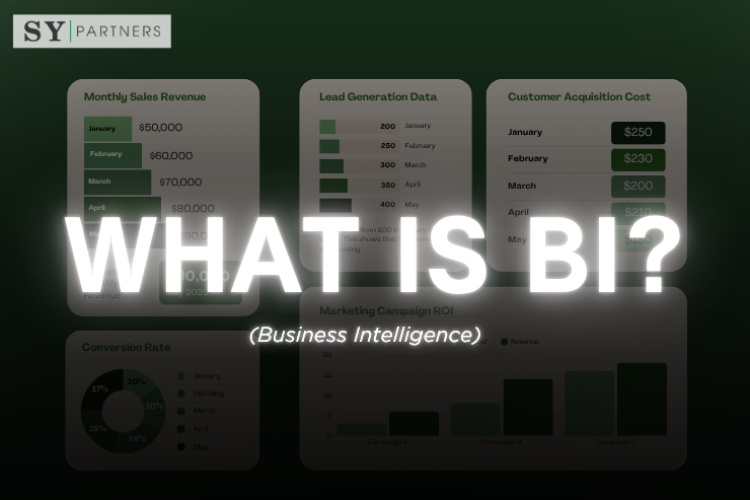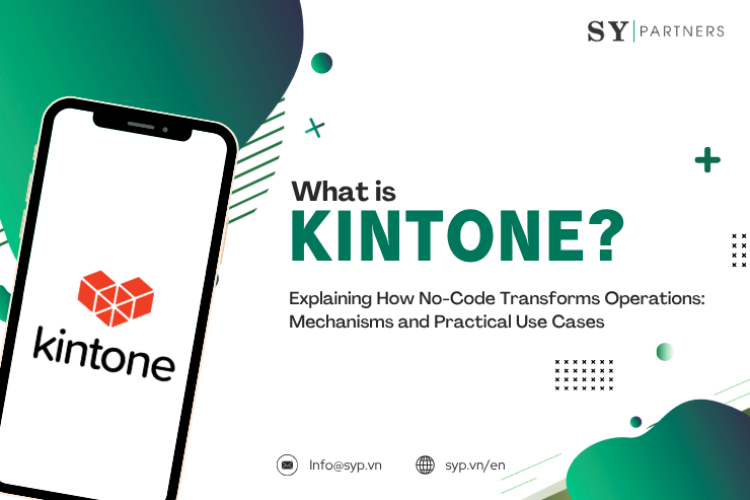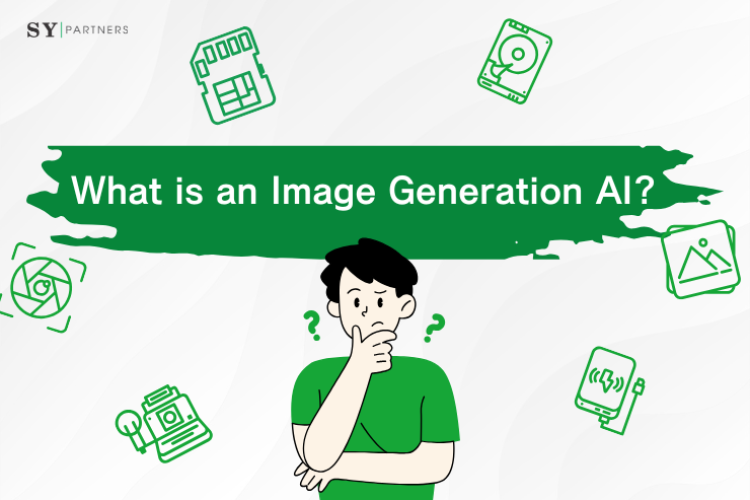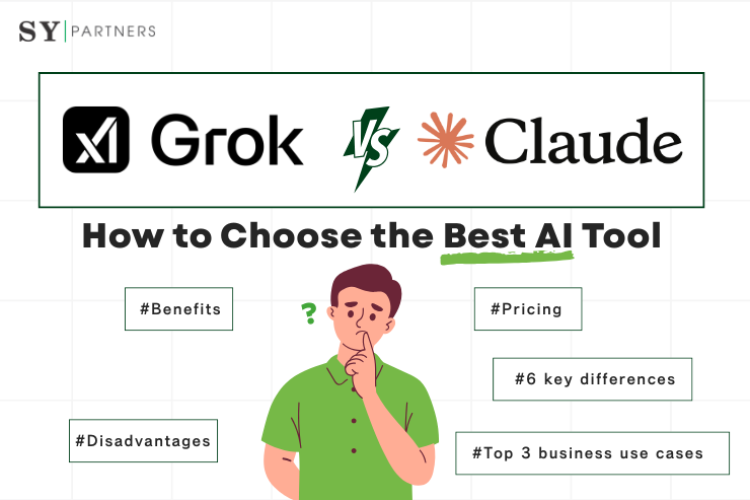Types of CMS and Their Features: A Comprehensive Guide to Choosing the Best Option for Website Development
A Content Management System (CMS) is an essential tool for streamlining the process of building and managing websites. Even without advanced programming knowledge, CMS platforms allow users to easily create, edit, and publish content. However, there are various types of CMS, each with distinct characteristics, suitable use cases, and potential challenges.
In this article, we will explore five major categories of CMS: Open-Source CMS, Cloud-based (SaaS) CMS, On-Premise/Package CMS, No-Code CMS, and Headless CMS. For each type, we will provide a detailed explanation of its features and present a two-column comparison table that highlights the disadvantages and challenges. This will help readers identify the most suitable CMS for their specific projects or business needs.
1. Open-Source CMS: Flexibility and the Power of Community
When you want to design and manage a website freely, one of the first options that comes to mind is an open-source CMS. Built and continuously improved by developers worldwide, this type of CMS is highly valued for its flexible customization and rich extensibility, meeting diverse needs across industries.
1.1 What is an Open-Source CMS?
An open-source CMS is a content management system whose source code is publicly available, allowing anyone to use, modify, and distribute it for free. Representative examples include WordPress, Drupal, and Joomla!, which are all developed and maintained primarily by their global communities.
1.2 Key Features
Open-source CMS platforms are attractive for their ability to adapt to a wide variety of projects. Their most well-known features include:
| Feature | Description |
|---|---|
| Open Source Code | Freely accessible, modifiable, and distributable by anyone |
| Community-Driven | Development and updates are continuously managed by the community |
| Extensibility | Easy to add new functionality via plugins or modules |
| Design Flexibility | Themes and templates allow highly customizable design changes |
| Multilingual Support | Many CMS platforms include multilingual capabilities for global use |
These features provide a highly customizable foundation that can be tailored to specific environments and business objectives.
1.3 Advantages and Disadvantages
While open-source CMS solutions offer significant advantages, there are also challenges to consider during adoption and operation.
| Advantages | Disadvantages |
|---|---|
| Free for anyone to use | Setup and customization may require technical expertise |
| Global user and developer community contributes to improvements | Support depends on the community and may lack immediacy |
| Wide range of plugins and themes for easy expansion | Plugin quality and security can vary greatly |
| High flexibility in design and functionality | Performance optimization may be necessary depending on the server/environment |
| No vendor lock-in | Security management must be handled by the user |
If leveraged effectively, open-source CMS enables highly flexible website operations—but it also requires a certain level of responsibility and technical skills on the operator’s side.
1.4 Use Cases
Open-source CMS platforms are particularly well-suited for scenarios where customization, scalability, and community-driven development are essential. Below are representative use cases with recommended tools:
| Use Case | Details | Recommended Tools |
|---|---|---|
| Content-Driven Sites | Blogs, news portals, and frequently updated content websites | WordPress |
| Large-Scale / Complex Sites | Corporate portals, educational institutions, government websites requiring multi-functionality and complex architecture | Drupal |
| Membership Sites | Community platforms or subscription-based services | Joomla!, WordPress (with plugins) |
| E-Commerce | Online shops using e-commerce extensions | WordPress (WooCommerce), Drupal Commerce |
| Design-Focused Sites | Projects prioritizing branding through unique themes or templates | WordPress, Joomla! |
Thanks to their flexibility and long-term sustainability, open-source CMS platforms are an excellent choice for web projects that require scalability and continuous development.
2. Cloud-Based CMS (SaaS): Ease of Use and Scalability
For those who want to launch a website quickly without technical expertise, a cloud-based CMS is the perfect solution. Since the service provider manages the entire infrastructure, users can focus solely on creating content, enabling fast and efficient website operations.
2.1 What is a Cloud-Based CMS?
A cloud-based CMS is hosted on the cloud and managed entirely through a web browser.
Examples include Wix, Squarespace, and Shopify. Its key characteristic is that users don’t need to worry about server management or software updates—the provider handles it all.
2.2 Key Features
The biggest advantage of a cloud-based CMS is that it can be set up without specialized technical knowledge. With the foundation already in place, users can focus on content creation.
| Feature | Description |
|---|---|
| Customization | Limited to template-based options; advanced customization can be difficult |
| Maintenance | Server management and updates handled by the provider |
| Ease of Setup | Drag-and-drop UI makes it beginner-friendly |
| Fast Deployment | Websites can go live in just minutes using templates |
| Scalability | Automatically adjusts resources to handle traffic spikes |
| Support | Robust customer support provided by the service provider |
This makes cloud-based CMS platforms highly efficient for quick website launches.
For example, Shopify is widely praised for enabling rapid e-commerce site deployment with built-in product management and payment systems.
2.3 Advantages and Disadvantages
Cloud-based CMS platforms are easy to use, but their flexibility and uniqueness can be limited.
| Advantages | Disadvantages |
|---|---|
| Easy to set up and beginner-friendly | Locked into the platform, making unique feature development difficult |
| Server management and updates handled by provider | Data migration and backups can be problematic |
| Rapid website deployment | Performance may suffer during high-traffic surges |
| Automatic scaling with traffic growth | Restricted to provider’s built-in features, may not cover special needs |
| Comprehensive customer support | Requires stable internet connection to function properly |
| Wide variety of design templates | Provider logos/branding or limitations may remain |
Cloud-based CMS solutions are reliable for beginners, but those seeking advanced customization or full brand consistency should be aware of their limitations.
2.4 Use Cases
Cloud-based CMS platforms are designed for flexible, efficient adoption across different scenarios. Below are common use cases and recommended tools:
| Use Case | Details | Recommended Tools |
|---|---|---|
| Small Businesses | Restaurants, cafés, and local shops needing a quick web presence | Wix, Squarespace |
| Entrepreneurs & Startups | Launching an online shop or service site with limited resources | Shopify |
| Beginner Users | Individuals who want to easily create blogs or content sites without technical skills | Wix, Jimdo |
| Short-Term Projects | Temporary campaign or event sites, such as for exhibitions | Squarespace, Weebly |
| Speed over Flexibility | Prioritizing ease of setup and speed over customization freedom | Wix, Shopify |
Since each platform has its own strengths, it’s important to choose one aligned with your purpose and operational style. This ensures you can maximize the speed and simplicity that cloud-based CMS offers.
3. Package CMS: Enterprise-Grade Stability and Integration
When it comes to large-scale corporate websites or global operations, the key requirements are stability and system integration.
Package-based CMS solutions provide a robust foundation for enterprise organizations by seamlessly integrating with existing systems while ensuring reliable performance.
3.1 What is a Package CMS?
A package CMS is delivered as licensed software that companies install and operate on their own servers.
Leading examples include Adobe Experience Manager and Sitecore, which are specifically designed for large enterprises.
3.2 Key Features
Package CMS platforms are often integrated into complex enterprise IT environments, offering strong stability and integration capabilities.
| Feature | Description |
|---|---|
| Customization | Supports advanced development, allowing flexibility for unique business needs |
| Integration | Easily connects with CRM, ERP, and other enterprise systems |
| Security | Managed in-house with detailed configuration options |
| Enterprise-Ready | Strong support for multi-language and multi-site management |
| Stability | Operates in dedicated server environments for consistent performance |
| Custom Functions | Can implement workflows and features tailored to business processes |
These features make package CMS platforms a preferred choice for global organizations or large enterprises with complex digital strategies.
For example, Adobe Experience Manager is widely used to deliver multi-language websites and personalized content at scale.
3.3 Advantages and Disadvantages
While package CMS platforms provide significant benefits, they also come with challenges related to cost, complexity, and vendor dependency.
| Advantages | Disadvantages |
|---|---|
| Highly customizable to specific business needs | Complex initial implementation, often requiring specialist teams |
| Strong integration with existing enterprise systems | Vendor lock-in makes migration difficult |
| Advanced security control | Updates and feature rollouts may be slow |
| Excellent support for multi-language/multi-site environments | Scalability limited by server infrastructure |
| Stable and reliable performance | Requires in-house expertise for management and maintenance |
For large organizations, the stability and integration of package CMS platforms are major advantages. However, companies must also carefully consider implementation costs and the risks of vendor lock-in.
3.4 Use Cases
Package CMS platforms are best suited for large-scale, complex, and global websites. Typical scenarios include:
| Use Case | Details | Recommended Tools |
|---|---|---|
| Global Enterprises | Managing multi-region, multi-language websites under one framework | Adobe Experience Manager, Sitecore |
| Complex System Integration | Seamlessly connecting with CRM, ERP, and other enterprise systems | Sitecore, Oracle WebCenter |
| Brand Consistency | Providing a unified brand experience across multiple international offices | Adobe Experience Manager |
| Advanced Workflow Management | Incorporating approval processes and personalized content delivery | Sitecore |
| Enterprise-Scale Operations | Supporting high-traffic or mission-critical services | Adobe Experience Manager, Sitecore |
Package CMS solutions are often adopted by enterprises with complex requirements or global strategies. They are especially valuable when businesses need to manage large-scale operations and integrated marketing strategies across multiple regions.
4. No-Code CMS: Build Quickly Without Technical Expertise
“The ability to create a website without writing a single line of code” — this simplicity is the biggest advantage of no-code CMS. With intuitive operations, anyone can launch a professional-quality website in a short time. This makes it particularly suitable for small businesses or short-term projects.
4.1 What is a No-Code CMS?
A no-code CMS is a content management system that allows users to build and manage websites without programming knowledge. Pages can be created intuitively through drag-and-drop interfaces and templates. Popular services include Wix, Squarespace, and Webflow.
4.2 Features
No-code CMS lowers the entry barrier to development and enables fast website launches.
| Aspect | Description |
|---|---|
| Customization | Relies on templates and plugins, though design flexibility has been improving each year. |
| Performance | Optimized by the platform, ensuring stable operation. |
| Ease of Use | Drag-and-drop interface allows anyone to build without technical expertise. |
| Development Speed | No coding required; websites can go live in just days to weeks. |
| Rich Templates | Industry-specific designs available for professional-quality sites instantly. |
| Automatic Updates | Security patches and feature updates handled by the service provider. |
Thanks to these characteristics, no-code CMS is especially effective for website projects that prioritize speed.
4.3 Advantages and Disadvantages
While highly convenient, no-code CMS has limitations in scalability and uniqueness.
| Advantages | Disadvantages |
|---|---|
| Usable without technical expertise | Limited by built-in functions and templates; hard to achieve full uniqueness |
| Quick deployment | Not suitable for large-scale services or complex workflows |
| Wide variety of design templates | Migration to another CMS can be difficult later |
| Independent from external developers | Vulnerable to service provider’s policy changes or shutdowns |
| Automatic updates keep the site secure and current | Limited ability to fine-tune SEO |
No-code CMS is ideal for small-scale websites or short-term usage, but less suitable for businesses that expect growth or require advanced/custom functionality.
4.4 Use Cases
No-code CMS proves effective in the following scenarios:
| Use Case | Details | Recommended Tools |
|---|---|---|
| Fast Deployment | Quickly launch campaign sites or event landing pages | Webflow, Wix |
| Small Business Websites | Restaurants, freelancers, personal portfolios | Squarespace, Wix |
| Lack of IT Resources | Teams without engineers can still manage websites independently | Wix, Jimdo |
| Simple Operations | Prioritizing ease-of-use over complex management needs | Webflow, Squarespace |
For projects requiring rapid launch or when resources are limited, no-code CMS is an effective solution.
5. Headless CMS: A New Wave in Modern Web Development
Delivering consistent content across web, mobile, and IoT has become a core requirement in today’s digital landscape. Headless CMS is designed to meet this demand by decoupling the front end from the back end, offering greater development flexibility and long-term scalability.
5.1 What is a Headless CMS?
A headless CMS manages content in the backend and distributes it to the frontend through APIs. Since the front and back are separated, it can easily support multiple channels such as websites, mobile apps, and IoT devices. Popular examples include Contentful and Strapi.
5.2 Features
Headless CMS excels in flexibility and multi-channel delivery. Its main characteristics are:
| Aspect | Description |
|---|---|
| Customization | High flexibility in the frontend; API-based development allows freedom. |
| Multi-channel | Distributes content across web, mobile apps, and IoT devices. |
| Development Speed | APIs accelerate frontend development. |
| Freedom of Development | Easily integrates with modern frameworks like React and Vue.js. |
| Scalability | API-driven architecture allows seamless expansion. |
| Modern Compatibility | Highly compatible with JAMstack and other modern development methods. |
This allows businesses to deliver content to multiple platforms efficiently from a single backend system.
5.3 Advantages and Disadvantages
| Advantages | Disadvantages |
|---|---|
| Strong multi-channel delivery | Requires advanced frontend development skills |
| API-based flexibility | Complex initial setup and integration |
| Integration with modern frameworks | May not be intuitive for non-technical administrators |
| Excellent scalability | Challenges with API response times and load management |
| Manage multiple channels from one backend | Limited content preview capabilities |
| Highly extensible architecture | Ecosystem still maturing; fewer ready-made tools available |
While the flexibility and future potential are highly appealing, the success of a headless CMS often depends on the technical expertise and structure of the development team.
5.4 Use Cases
Headless CMS is best suited for scenarios that require consistent content delivery across multiple channels or where modern development practices are adopted.
| Use Case | Details | Recommended Tools |
|---|---|---|
| Multi-channel distribution | Deliver content to web, mobile, and IoT simultaneously | Contentful, Strapi |
| Media companies | Publish articles and videos across multiple devices | Contentful |
| Modern development environments | Integration with React, Vue.js, or other frameworks | Strapi, Sanity |
| Scalable services | Handle rapid traffic growth and global expansion | Contentful, Kentico Kontent |
| Developer-driven operations | Fully customized design and frontend | Strapi, Webflow (headless integration) |
For companies driving modern web strategies or those that need cross-channel content delivery, a headless CMS is a highly effective choice.
Conclusion
The choice of a CMS depends on business goals, budget, and technical resources. Open-source CMSs are cost-effective and flexible, making them suitable for small and medium-sized businesses, though security and maintenance can be challenging. Cloud-based CMSs are easy to adopt but may have limitations in customization and higher long-term costs. Packaged CMSs provide stability and integration for large enterprises but come with high costs and complex implementation. Fully custom-built (scratch) CMSs offer maximum flexibility but require significant time and financial investment.
Meanwhile, headless CMSs excel in modern development and multi-channel content delivery but demand advanced technical expertise. By understanding the strengths and challenges of each CMS type, you can select the most suitable option for your project, enabling efficient and effective website management. Strategic use of CMSs can ultimately drive business success.


 EN
EN JP
JP KR
KR